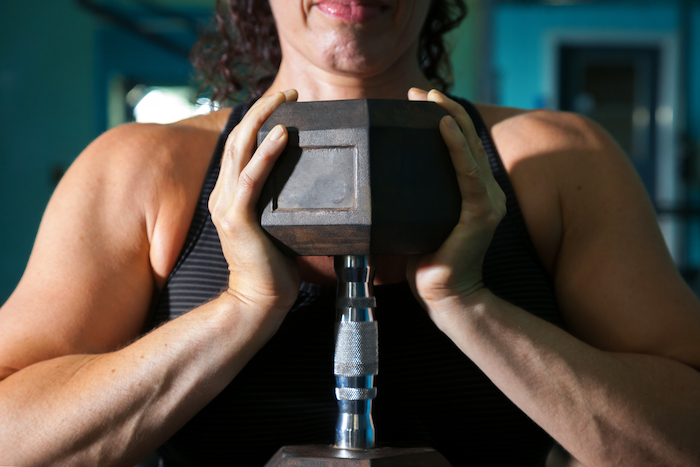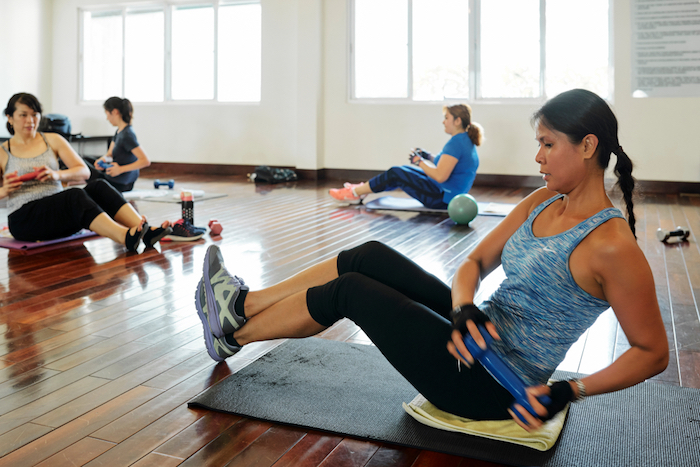Imagine these scenarios.
You walk into the gym ready to train and it’s packed, and all the squat racks and benches are taken. Or your boss calls you into work early because of an important deadline and you don’t have time for your usual workout. You feel crushed.
Crap. You were really looking forward to your heavy deadlifts this morning.
So, what do you do?
Rather than walk out of the gym, get annoyed, or skip your training altogether, grab a dumbbell and do the following one dumbbell routines below.
These routines will work your body from head-to-toe while working on strength imbalances due to the unilateral nature of using one dumbbell.

2 Advantages of Unilateral Training with a Dumbbell
Improved Muscle Recruitment
Unilateral training makes you work harder and recruit more muscle fibers to do the same movement. Think about a split squat: while you’re using less weight than you would with a barbell squat, you’re still recruiting most of your muscles to stabilize and maintain form.
Taking one leg out of the equation forces the abductors and core to stabilize the pelvis while the working leg performs a split squat. Working more muscle with less weight will help correct strength imbalances between sides, too.
Core Work Without Crunches
When training unilaterally, you automatically throw your body off-balance, forcing your entire core to engage to keep yourself balanced and upright.

How to Design a Workout
This template can be made adaptable to your goals. If you want to substitute an isolation exercise (triceps, shoulders, biceps etc.) instead of a core exercise, do it. Or if you want to really focus on strength imbalances in your lower body, do two single leg exercises instead of one.
The Template
Do exercises 1A through 1C, one after the other with little rest in between. Repeat for a total of 3-4 rounds. Then do the same with 2A through 2C. Rest when needed between sets and circuits.
1A. Bilateral leg exercise
1B. Upper body pull exercise
1C. Core/isolation exercise
2A. Single leg exercise
2B. Upper body push
2C. Core/isolation exercise
Note: Use a weight that allows you to complete each repetition with good form. Do the isolation exercises for 12-15 reps and core exercises for 30-60 seconds.
Repetition Ranges
Use the following repetition ranges, dependent on your goals
- Strength: 4-6 reps
- Muscle: 8-12 reps
- Endurance: 12-15 reps
Including the warm up, this should take you no longer than 30-40 minutes.

One Dumbbell Routine Examples
1A. Goblet squat
1B. One arm dumbbell row
1C. Plank with dumbbell transfer
2A. Goblet side lunge
2B One arm bench press
2C. Dumbbell twist
OR
1A. Sumo squat
1B. Deadstop row
1C. Lateral shoulder raise
2A. Goblet Spilt Squat
2B. Seated one arm shoulder press
2C. Suitcase carry 40 steps in each hand
Other exercises to plug in might include: Snatches, bent over rows, deadstop rows, single arm rows, plank rows, push presses, floor presses, sumo squats, good mornings, side planks, reverse lunges, single leg deadlifts, pullovers, shoulder presses, tripod rows, straight arm crunches, suitcase carries, and goblet split squats.
Wrapping Up
When pressed for time or you have a lack of equipment, grabbing a dumbbell and getting after it and not skipping your training will help correct strength imbalances and keep the gain train on track.
Featured image via The Light Photography/Shutterstock